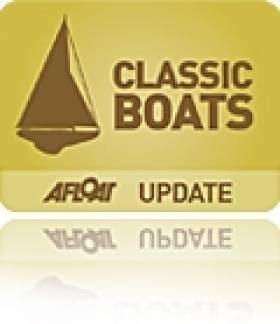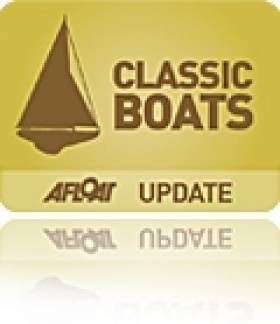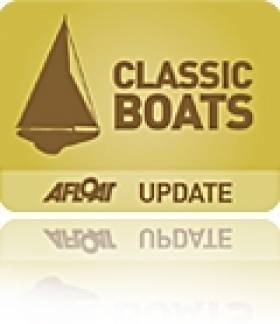Displaying items by tag: Naom Eanna
Naomh Éanna Aran Islands Ship TV Documentary Airs Tonight On TG4
#naomheanna – Donncha Mac Con Iomaire's maritime programme on the Naomh Éanna ship airs tonight on TG4 at 21:30. Rusted and with little future she was sentenced to be scrapped, until a few men embarked on a plan to bring new life to the Naomh Éanna. The news of the bid to rescue her from Grand Canal Dock was told by Afloat.ie last February and now the tale makes the small screen.
The Naomh Éanna provided all the neccessities the three Aran Islands had with the mainland for 30 years. CIÉ's rivited ship brought everything from summer students and sheep to Galway, and ice cream and coal to the windswept isles. The Naomh Éanna was at the end of a great era of shipbuilding in Dublin but was ill-designed to service three islands in which she could only moor at one pier! The curragh men of Inis Meáin and Inis Oirr battled the wild Atlantic to keep connected to the outside world.
If you missed it the Docu is now on the TG4 player here
Naomh Éanna Trust Save Our Ship (SOS) Campaigners Launch Fundraiser Appeal to Survey Ship for Restoration Plans
#NaomÉanna – Following last week's meeting between Irish Ship & Barge Fabrication Co and Minister for Heritage, over a €1.85m plan to restore former Aran Islands ferry Naom Éanna, in which campaigners described the meeting "as not constructive" however a fundraiser appeal is underway so to survey the vessels-riveted hull, writes Jehan Ashmore.
According to the Naomh Éanna Trust's Save Our Ship (SOS) campaign, both Waterways Ireland and Department of Heritage are reluctant to have any relationship with the restoration of the historic vessel, which has been berthed in Dublin Port's Grand Canal Basin for a quarter century and faces potential scrapping.
Both parties were at pains to point out they will not support the restoration project financially and as to breaking up the ship, this does not involve dry-docking.
As for the campaigners, the costs to survey the vessel in dry dock amounts to €15,000 and no funds would not be met by the minister.
The Trust's ship-survey fundraiser appeal seeks a minimum donation of €10, which would include names of contributors listed on an appeal plaque placed on board.
The campaigners cite without a hull survey to ascertain how much work is involved, they would not be in a posiiton to approach an investor or institution regarding the proposed plans to convert the Liffey Dockyard 1958 built vessel.
The plans consist of a restaurant, hostel, micro-brewery, café and museum ship and relocation to her old homeport of Galway Harbour, in which the port company have given their support of a permanment berth.
Naom Éanna (without the letter 'h') as she is spelt on her 137ft riveted hull, makes this vessel historically significant in terms of her been the oldest surviving Irish built ship constructed of this technique and is said to be one of the last surviving examples in the world.
The survey would not only require an inspection of the hull's keel and ballast tanks that can only be carried out while the ship remains in dry dock but the process also requires timbers and renting machinery.
In addition to removing rubble from the 200 year-old NAMA owned dry-dock in which she currently occupies in the Grand Canal Dock Basin close to her old berth along Charlotte Quay.
The Naomh Éanna Trust are also appealing to any group that might provide diving assistance? in the dry-dock so to survey the blocks and put the timbers in place.
As mentioned, the trust are seeking donations (see their Facebook link to donate) as a first step of progressing plans to restore the vessel through dry-docking. The facebook campaign page includes updates and comments following the story.
In addiiton the trust in recent weeks launched an online petition campaign (to date 600 signatures) to raise public awareness of the vessels heritage value and primarily to prevent the vessel broken-up.
#NaomÉanna- Lorna Siggins of The Irish Times writes that Minister Jimmey Deenihan at the Department of Arts, Heritage and Gaeltacht has said that any proposal to save the former Aran island ferry Naomh Éanna will have to include a "concrete business plan".
Mr. Deenihan has put a four-week stay on plans by Waterways Ireland to break up the ferry, and had agreed to meet representatives of the campaign seeking to have the ship saved.
The ferry, which once carried passengers such as James Joyce Ulysses publisher Sylvia Beach and writer Brendan Behan on its regular runs between Galway and the Aran islands, is in dry dock in Dublin's Grand Canal basin, awaiting dismantling.
However, Inland Waterways Association of Ireland ship restorer Sam Field Corbett and a number of public officials believe the vessel as previously reported on Afloat should be saved and refurbished.
As previously reported on Afloat.ie, there are proposals to move the veteran vessel to her old homport of Galway and become a floating maritime museum and form a focal point as part of plans to re-develop the inner harbour.
#NaomÉanna- According to Galway Bay FM, Galway Port Company said it would be happy to provide a permanent home for an old ferry, Naom Éanna, which once linked Galway to the Aran Islands.
The port's harbourmaster, Captain Brian Sheridan says Galway docks would be an ideal location for the Naomh Éanna as a tourist attraction.
Gaeltacht Minister Jimmy Deenihan has put a stay on scrapping the Naomh Eanna until the end of March.
The vessel has been housed at Dublin's Grand Canal, but a proposal was put forward to scrap it, which is being opposed by the Inland Waterways Association of Ireland and other maritime groups.
Among the campaigning groups are the Naomh Éanna Trust's SOS Save Our Ship which in co-operation with Sam Field-Corbett of the Irish Ship & Barge Fabrication Co, are hoping for funding from private investors, so to save the vessel from scrapping by Waterways Ireland.
Due to the reprieve date of less than four-weeks to go this month, Stephen Payne of the Naomh Eanna Trust also speaking to Galway Bay FM, has said that the IS&BF would not be able to secure a berth for her in the Dublin Port for at least the next two years.
It is proposed instead to sail the vessel under own steam to Galway Port, this would involve spending €180,000 to bring her to a seaworthy state. Mr. Payne added the engines were in working order.
To completely carry out a full restoration to her former glory would be in the region of €1.8m to €2m.
Afloat.ie adds that the trust's SOS Save Our Ship campaign's online petition to save the heritage ship at time of posting stands at more than 300 signatures.
Hopes ‘Raised’ for former Lifeboat’s Saving yet Lack of Reprieve Time for Naom Éanna, Campaigners Claim
#HeritageVessels – Following Afloat.ie's weekend coverage of the removal of former RNLB Mary Stanford from Dublin's Grand Canal Dock Basin in Ringend from where she was loaded onto a lorry bound for her original homeport of Ballycotton, further updates will be made in following the progess of her restoration project.
The Barnett-class lifeboat which rescued all 6-crew of the Daunt Rock lightship in 1936 is to relocated to a new plinth overlooking the sea at the East-Cork location. In addition the campaigners of the Mary Standford Project are seeking donations to restore the vessel to her former glory.
During the lifeboat's hoisting operation which involved her removal by the slipway next to the Naom Éanna, the historic heritage ship that once served the Galway-Aran Islands ferry service until she was withdrawn in 1988. She retired to Dublin where she was recently moved from her berth to a nearby graving dock (see photo).
The 1958 built vessel said to be "one of the last riveted ships built in the world" was granted a one-month reprieve to save her from the shipbreakers-torch, following an intervention of the Seanad.
As reported today, campaigners have expressed disappointment at what they claim is too short a stay of execution for the 137ft vessel.
Sam Field Corbett, of the SaveOurShip campaign and marine heritage restoration business Irish Ship & Barge Fabrication, said it had been made clear before last week's debates in Leinster House that 16 weeks would be required to prepare such a plan "involving no State funding".
In the meantime, an online petition has been launched to urge Government to extend the Naomh Éanna's life beyond the present 31 March deadline.
Naom Éanna Given Months Stay of Execution by Seanad Éireann
#NaomÉanna- The historic heritage ship, Naom Éanna, a former Aran Islands ferry has been granted a month's stay from scrapping, following a decision by Seanad Éireann, writes Jehan Ashmore.
The sudden turn-around of events follows less than a week ago, as previously reported the decision by Minister Deenihan of the Department of Arts & Heritage and the Gaeltacht to reject an appeal by campaigners to save and restore the Liffey Dockyard built vessel from scrapping by Waterways Ireland.
The 438 grt vessel is the oldest surviving example of an Irish ship completed using riveted-hull construction techniques, having been launched in 1958 as yard No. 176. It is also said to be 'one of the last riveted ships built in the world'. The 137 foot was moved last Wednesday from her Grand Canal Basin berth due to safety concerns following hull inspection along Charlotte Quay, home to the vessel for more than a quarter century. She is currently berthed in a nearby 200 year-old graving dock owned by NAMA.
Last week also saw the installation of a new graving dock gate that was hoisted in position by a crane, to allow the facility to pump out water and provide a 'dry' dock for Naom Eanna. In order for campaigners to save her, some €100,000 costs to Waterways Ireland would need to be met, on top of insuring the vessel and permission from NAMA to hold her in dry dock until repairs could begin.
Among those campaigning is the Naomh Éanna Trust which has been calling for the vessels reprieve so to enable efforts to save the ship. Sam Field Corbett of the Irish Ship & Barge Fabrication Co. (IS&BF) has also sought time to implement a business plan to attract private investment for the vessel to be part of a Dublin-based 'maritime quarter'. In addition several T.D.'s lent their support during a debate in Dail Eireann.
The IS&FC has worked on several vessels, notably, the former Cobh based liner-tender, Cill Airne, also built by Liffey Dockyard. Likewise of Naom Eanna, she is a riveted hulled ship completed in 1962 and was restored into service in 2006 as a floating restaurant and bar venue on the Liffey near the Convention Centre.
For three decades the Naom Eanna had operated CIÉ's passenger and livestock three-hour ferry service between Galway City and the Aran Islands.
She appeared in many TV documentaries which depicted the unique way of life of the islanders and the only main form of a lifeline with the mainland, bringing people, cargo and livestock. The latter presented an iconic image as cattle were slung from the ship's hold and lowered into the water to swim ashore while escorted by currach crews to the smaller islands of Inishmaan and Inishsheer, while at Inishmore, the largest island had a pier to disembark livestock.
In 1988 she was withdrawn from Galway Bay service, having failed new safety conditions introduced. She then relocated to Dublin Port's northside Alexandra Basin, where she was laid-up at the lead-in jetty of the old listed graving dock (currently in-filled in recent years) close to former site of the Liffey Dockyard.
The following year the Irish Nautical Trust took her over and she moved southside to the Grand Canal Dock Basin, where she was home to several onboard businesses.
Department of Arts & Heritage Rejects Appeal to Save Naom Éanna
#NaomEanna – The campaign to save the Ballycotton Lifeboat is secure however the fate of former Aran Islands ferry Naomh Éanna despite support of some T.D.'s to save her is according to The Irish Times rejected by the Department of Arts, Heritage and the Gaeltacht as the vessel is due to be broken up by Waterways Ireland.
The department said that "the decision has not been taken lightly", but is "necessary because of the continuing serious risk posed by the vessel", which has been in Dublin's Grand Canal Basin for almost 30 years.
The ship, built in Dublin's Liffey Dockyard in 1956, served the Galway to Aran island sea route for 30 years, before being acquired from State owner CIÉ by the Irish Nautical Trust. It was laid up in 1986.




































































